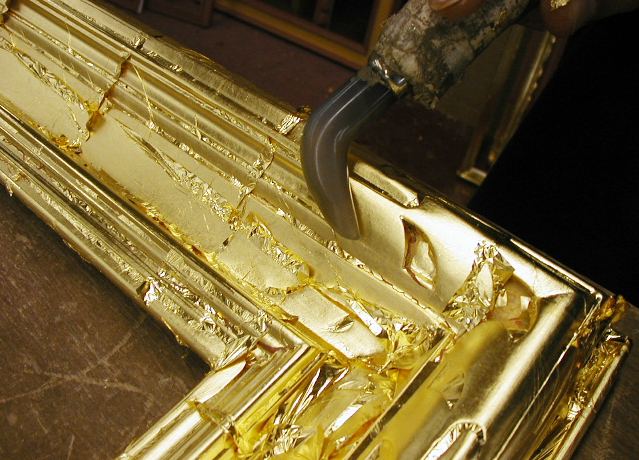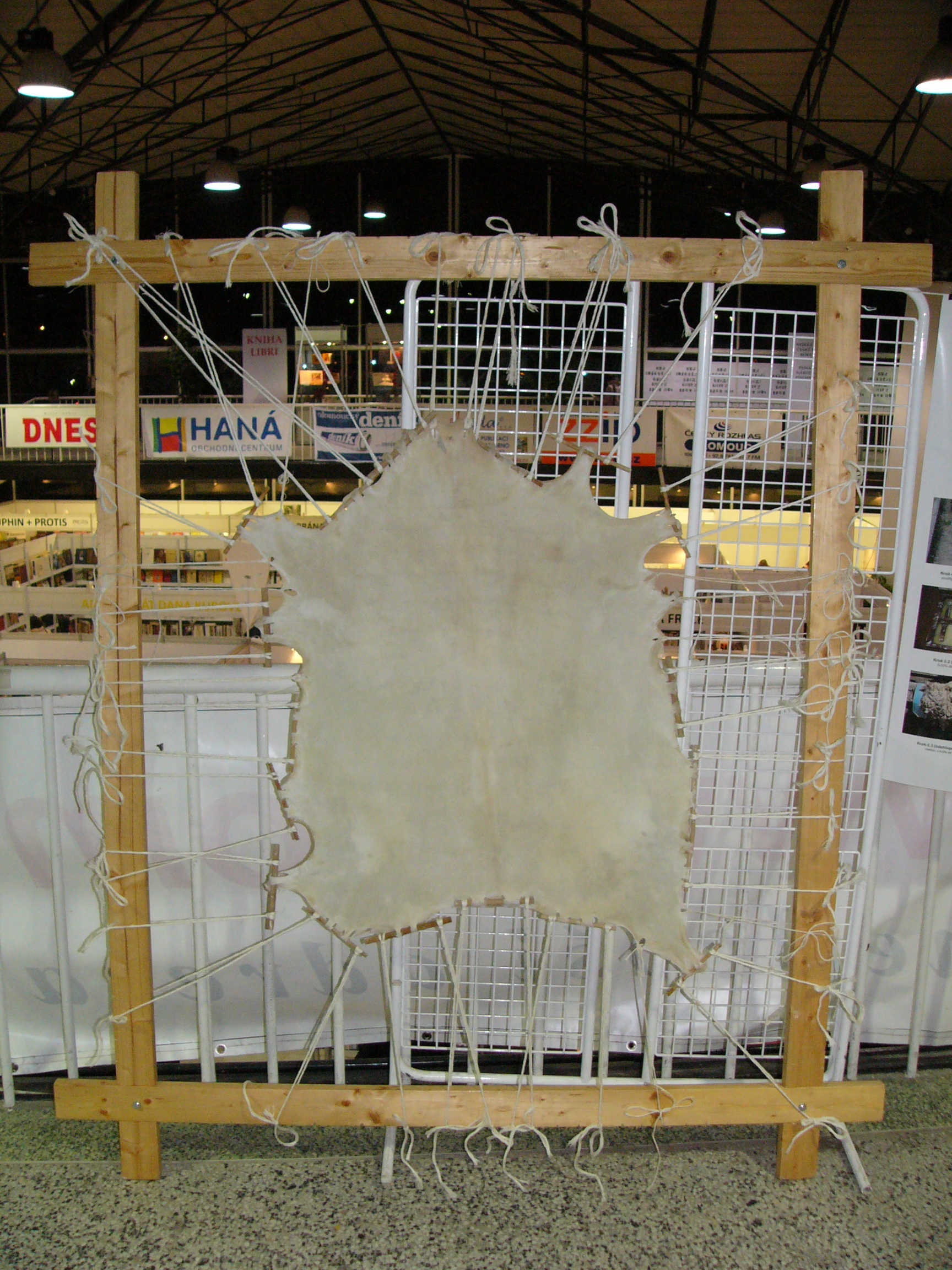|
Goldbeating
upA gold nugget of 5 mm (0.2 in) in diameter (bottom) can be expanded through hammering into a gold foil of about 0.5 m2 (5.4 sq ft). The Japan.html" ;"title="Toi gold mine museum, Japan">Toi gold mine museum, Japan. Gold leaf is gold that has been hammered into thin sheets (usually around 0.1 μm thick) by a process known as goldbeating, for use in gilding. Gold leaf is a type of metal leaf, but the term is rarely used when referring to gold leaf. The term ''metal leaf'' is normally used for thin sheets of metal of any color that do not contain any real gold. Gold leaf is available in a wide variety of karats and shades. The most commonly used gold is 22-karat yellow gold. Pure gold is 24 karat. Real, yellow gold leaf is approximately 91.7% pure (i.e. 22-karat) gold. Traditional water gilding is the most difficult and highly regarded form of gold leafing. It has remained virtually unchanged for hundreds of years and is still done by hand. History Mycenaean necklac ... [...More Info...] [...Related Items...] OR: [Wikipedia] [Google] [Baidu] |
Gilding
Gilding is a decorative technique for applying a very thin coating of gold over solid surfaces such as metal (most common), wood, porcelain, or stone. A gilded object is also described as "gilt". Where metal is gilded, the metal below was traditionally silver in the West, to make silver-gilt (or ''vermeil'') objects, but gilt-bronze is commonly used in China, and also called ormolu if it is Western. Methods of gilding include hand application and gluing, typically of gold leaf, chemical gilding, and electroplating, the last also called gold plating. Parcel-gilt (partial gilt) objects are only gilded over part of their surfaces. This may mean that all of the inside, and none of the outside, of a chalice or similar vessel is gilded, or that patterns or images are made up by using a combination of gilt and ungilted areas. Gilding gives an object a gold appearance at a fraction of the cost of creating a solid gold object. In addition, a solid gold piece would often be too soft or to ... [...More Info...] [...Related Items...] OR: [Wikipedia] [Google] [Baidu] |
Metal Leaf
A metal leaf, also called composition leaf or schlagmetal, is a thin foil used for gilding and other forms of decoration. Metal leaves can come in many different shades, due to the composition of the metal within the metal leaf. Examples of this variation of shades in metal leaves can be found in Ancient Egyptian gold leaves, as the silver content within the gold leaves could make them appear bright yellow or paler shades of yellow. Some metal leaves may look like gold leaf but do not contain any real gold. This type of metal leaf is often referred to as imitation leaf. Metal leaves are usually made of gold (including many alloys), silver, copper, aluminium, brass (sometimes called " Dutch metal" typically 85% Copper and 15% zinc) or palladium, as well as platinum. Gilding Gilding is the process of applying a thin layer of metal on another surface. Goldbeating, the technique of producing metal leaves, has been known for more than 5,000 years. A small gold nugget 5 mm ... [...More Info...] [...Related Items...] OR: [Wikipedia] [Google] [Baidu] |
Small Gold Nugget 5mm Dia And Corresponding Foil Surface Of Half Sq Meter
Small means of insignificant size. Small may also refer to: Science and technology * SMALL, an ALGOL-like programming language * ''Small'' (journal), a nano-science publication * <small>, an HTML element that defines smaller text Arts and entertainment Fictional characters * Small, in the British children's show Big & Small Other uses * Small (surname) * List of people known as the Small * "Small", a song from the album ''The Cosmos Rocks'' by Queen + Paul Rodgers See also * Smal (other) Smal may refer to: People * (1927-2001), Dutch musician * Georges Smal (1928–1988), Belgian writer * Gert Smal (born 1961), South African rugby player * Gijs Smal (born 1997), Dutch football player * (born 1939), Belgian politician; a memb ... * Smalls (other) {{disambiguation ... [...More Info...] [...Related Items...] OR: [Wikipedia] [Google] [Baidu] |
Intestine
The gastrointestinal tract (GI tract, digestive tract, alimentary canal) is the tract or passageway of the digestive system that leads from the mouth to the anus. The tract is the largest of the body's systems, after the cardiovascular system. The GI tract contains all the major organs of the digestive system, in humans and other animals, including the esophagus, stomach, and intestines. Food taken in through the mouth is digested to extract nutrients and absorb energy, and the waste expelled at the anus as feces. ''Gastrointestinal'' is an adjective meaning of or pertaining to the stomach and intestines. Most animals have a "through-gut" or complete digestive tract. Exceptions are more primitive ones: sponges have small pores ( ostia) throughout their body for digestion and a larger dorsal pore ( osculum) for excretion, comb jellies have both a ventral mouth and dorsal anal pores, while cnidarians and acoels have a single pore for both digestion and excretion. The human gas ... [...More Info...] [...Related Items...] OR: [Wikipedia] [Google] [Baidu] |
Karat (purity)
The fineness of a precious metal object (coin, bar, jewelry, etc.) represents the weight of ''fine metal'' therein, in proportion to the total weight which includes alloying base metals and any impurities. Alloy metals are added to increase hardness and durability of coins and jewelry, alter colors, decrease the cost per weight, or avoid the cost of high-purity refinement. For example, copper is added to the precious metal silver to make a more durable alloy for use in coins, housewares and jewelry. Coin silver, which was used for making silver coins in the past, contains 90% silver and 10% copper, by mass. Sterling silver contains 92.5% silver and 7.5% of other metals, usually copper, by mass. Various ways of expressing fineness have been used and two remain in common use: ''millesimal fineness'' expressed in units of parts per 1,000 and '' karats'' or ''carats'' used only for gold. Karats measure the parts per 24, so that 18 karat = = 75% gold and 24 karat gold is considered 10 ... [...More Info...] [...Related Items...] OR: [Wikipedia] [Google] [Baidu] |
Oxford University Press
Oxford University Press (OUP) is the publishing house of the University of Oxford. It is the largest university press in the world. Its first book was printed in Oxford in 1478, with the Press officially granted the legal right to print books by decree in 1586. It is the second-oldest university press after Cambridge University Press, which was founded in 1534. It is a department of the University of Oxford. It is governed by a group of 15 academics, the Delegates of the Press, appointed by the Vice Chancellor, vice-chancellor of the University of Oxford. The Delegates of the Press are led by the Secretary to the Delegates, who serves as OUP's chief executive and as its major representative on other university bodies. Oxford University Press has had a similar governance structure since the 17th century. The press is located on Walton Street, Oxford, Walton Street, Oxford, opposite Somerville College, Oxford, Somerville College, in the inner suburb of Jericho, Oxford, Jericho. ... [...More Info...] [...Related Items...] OR: [Wikipedia] [Google] [Baidu] |
Parchment
Parchment is a writing material made from specially prepared Tanning (leather), untanned skins of animals—primarily sheep, calves and goats. It has been used as a writing medium in West Asia and Europe for more than two millennia. By AD 400 most literature in these regions that was intended for preservation began to be transferred from papyrus to parchment. ''Vellum'' is a finer-quality parchment made from the skins of young animals such as lambs and young calves. The generic term ''animal membrane'' is sometimes used by libraries and museums that wish to avoid distinguishing between parchment and vellum. Parchment and vellum Today the term ''parchment'' is often used in non-technical contexts to refer to any animal skin, particularly goat, sheep or cow, that has been scraped or dried under tension. The term originally referred only to the skin of sheep and, occasionally, goats. The equivalent material made from calfskin, which was of finer quality, was known as ''vellum'' ... [...More Info...] [...Related Items...] OR: [Wikipedia] [Google] [Baidu] |
Mylar
BoPET (biaxially oriented polyethylene terephthalate) is a polyester film made from stretched polyethylene terephthalate (PET) and is used for its high tensile strength, chemical stability, dimensional stability, transparency reflectivity, and electrical insulation. When metallized, it has gas and moisture barrier properties. The film is "biaxially oriented", which means that the polymer chains are oriented parallel to the plane of the film, and therefore oriented over two axes. A variety of companies manufacture boPET and other polyester films under different brand names. In the UK and US, the best-known trade names are Mylar, Melinex, Lumirror and Hostaphan. It was the first biaxially oriented polymer to be manufactured on a mass commercial scale. History BoPET film was developed in the mid-1950s,Izard, Emmette Farr"Production of polyethylene terephthalate" U.S. patent no. 2,534,028 (filed: 1948 May 13; issued: 1950 December 12). originally by DuPont, Imperial Chemical ... [...More Info...] [...Related Items...] OR: [Wikipedia] [Google] [Baidu] |



